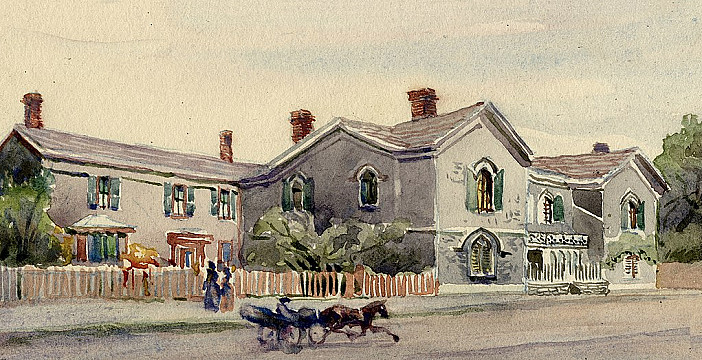Berkeley House
311 King Street East, Toronto, Ontario
Built from 1795, by George Porter a former Sergeant in the British Army who became a carpenter. The large log cabin on his 1-acre plot was purchased in the same year for $50 by Major John Small (1746-1831) who incorporated it into a new substantial, white stuccoed, double-gabled house that stood on the corner of Berkeley Street and King Street East near to Government House. It was either named for Small's native home - Berkeley in Gloucestershire - or his patron, the 5th Earl of Berkeley. Major Small accumulated further land around his new home until he was the owner of a 472-acre estate roughly bounded by today's Coxwell, Danforth, and Woodbine Avenues, and down to the lake. In 1824, he sold 120-acres to William Botsford Jarvis on which he would build Rosedale. It was the Major's son, Charles, who enlarged the house to 13-rooms....

This house is best associated with...
Major Small was chief clerk to the Executive Council but he is remembered as the victor of the first duel fought in York (Toronto) against Attorney-General John White. It started when Mrs Small publicly snubbed the "notoriously quarrelsome" Mrs White. Her husband then wrote to Sir David William Smith, smearing Mrs Small's reputation. He claimed she had been the mistress to the Earl of Berkeley until he tired of her and then supposedly paid Small to marry her and take her to the colonies where for a time (before Mrs White arrived from England) she had been White's mistress too! When the gossip became public, Small demanded immediate satisfaction. On January 3rd, 1800, Small's shot shattered his former friend's spine and White died half-paralysed and in agony 36-hours later. Small was acquitted, but his career was finished and his wife's reputation never recovered.
After Small died in 1831, the house was inherited by their younger son, Charles Coxwell Small, who also succeeded his father as chief clerk to the Executive Council. He enlarged the house into a "rambling villa" of 13-rooms (the largest of which was 18-by-45-feet) by adding a wing and giving it a fashionable makeover with Gothic-style windows. He lived here with his wife and seven children. The farm still consisted of just under 500-acres and Charles raised prize-winning cattle and held ploughing matches in his fields.
By 1870, what was once quiet countryside - where Charles had grown up shooting quail among the beds of wild asparagus - had now become home to factories and mills and his heirs subdivided the home into three which they leased to various tenants. However, the land around "Small's Pond" (created by Charles when he dammed Woodbine Creek) was opened up to the public by his son, Charles Jr., in 1896 and became known as "Small's Park," popular for boating, fishing, skating, and cycling for nearly 30-years.
In 1925, the old villa (which had by then fallen into a poor state of repair) and what remained of the land around it was purchased by The Copland Brewing Co. and it was demolished that year. It wasn't until 2012 when the new Globe and Mail Centre was built in it place that the foundation was unearthed and excavated.
After Small died in 1831, the house was inherited by their younger son, Charles Coxwell Small, who also succeeded his father as chief clerk to the Executive Council. He enlarged the house into a "rambling villa" of 13-rooms (the largest of which was 18-by-45-feet) by adding a wing and giving it a fashionable makeover with Gothic-style windows. He lived here with his wife and seven children. The farm still consisted of just under 500-acres and Charles raised prize-winning cattle and held ploughing matches in his fields.
By 1870, what was once quiet countryside - where Charles had grown up shooting quail among the beds of wild asparagus - had now become home to factories and mills and his heirs subdivided the home into three which they leased to various tenants. However, the land around "Small's Pond" (created by Charles when he dammed Woodbine Creek) was opened up to the public by his son, Charles Jr., in 1896 and became known as "Small's Park," popular for boating, fishing, skating, and cycling for nearly 30-years.
In 1925, the old villa (which had by then fallen into a poor state of repair) and what remained of the land around it was purchased by The Copland Brewing Co. and it was demolished that year. It wasn't until 2012 when the new Globe and Mail Centre was built in it place that the foundation was unearthed and excavated.
You May Also Like...
Categories
Styles
Share
Connections
Be the first to connect to this house. Connect to record your link to this house. or just to show you love it! Connect to Berkeley House →














